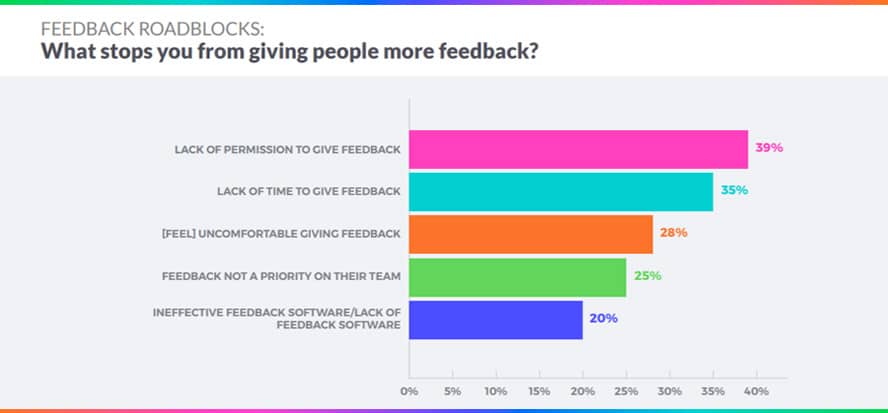How to create a feedback culture (even working remotely)
The abrupt and unplanned transition to a mass remote working model that forced most people to adapt to new work routines caused 49% of employees to feel that their productivity had decreased.
The alarming decline in productivity perceived by employees pinpoints the loss of clarity surrounding job expectations as companies scramble to adapt to the new normal. During these challenging and ever-changing times, it is critical to ensure employees fully understand what is expected of them so that they can focus their energy on areas where their work can stand out and make a difference.
First, it is important to provide employees with guidance in setting their goals and objectives. The second step is perhaps more challenging for leaders: helping them achieve these objectives in the most effective way possible. What information and support can we provide them with? And, how can we encourage them to continue their professional growth, even in situations of crisis and change?
This is where creating a feedback culture can be invaluable.
Feedback is a space for constructive conversations about people’s behaviors and skills. For organizations, it is a valuable process for their economic growth. For employees, it is a vital component of their personal and professional development. However, according to a Globant study, 72% of respondents said they were not satisfied with their company’s feedback process.
How can we improve the feedback process and create a culture where generating such conversations is the norm?
As we continue to adjust to so many changes in how we work, it may seem like knowing how to give and receive feedback has lost certain urgency but that would be a misconception. Continuous feedback is the most direct way to monitor the pulse of your employees. And in complex and highly uncertain times, keeping close to people is the best way to help them achieve their goals and motivate them to be their best selves.

Making feedback meaningful
“Before implementing a feedback program or acquiring a feedback platform the company needs to ask why it wants one and what are results it is looking to achieve,” says María Noel Bortolini, Talent Development Leader at Globant. “The more clarity a company has about the skills and behaviors it expects from its employees, the more meaningful conversations with invaluable transformation potential feedback will enable.”
The organization must be convinced that through feedback people can improve, develop, and achieve its objectives, which will have a direct impact on the organization’s goals. In the words of Simon Sinek, “feedback fosters a culture of growth.”
Feedback can positively transform people, which is why it is said to be a gift. The company is responsible for giving it meaning, giving it value, and inspiring people to give and receive it continuously.
Focus on qualities

When organizations talk about feedback, an unintended result can be to put employees on the defensive. This happens when employees associate feedback with annual performance reviews and compensation. This has led to feedback getting a bad rap that needs to be eradicated.
“Too often after goals are set, the next time they are re-visited is when they are being evaluated (e.g., exceeded, met, did not achieve) without any opportunity to touch base in between those two instances. Many people may need help knowing how to best achieve those objectives on the way. The problem with using absolute indicators is that they either don’t provide enough information on how a person can improve their performance moving ahead, or they are lagging indicators as a person cannot go back and change their performance in the past,” says Sanja Licina, Ph.D., Future of Organization Studio Leader at Globant. “But if employees receive constructive support and suggestions aligned with their objectives, they will understand what they need to improve to achieve their goals in time to still proactively impact the outcome. Objectives state what needs to be achieved and feedback indicates how to do it better and faster.”
Feedback provides clarity about opportunities for improvement and maps out a path of growth without which transformation is much more challenging.
Generate a culture of 360° feedback
In order for this back-and-forth to flow, it is important to create an environment in which everyone feels comfortable and knows how to give feedback. However, research shows that 70% of employees feel inhibited when giving feedback.

Some critics of 360° feedback have argued that it is very difficult to be truly objective because a person’s perspective is limited to their interactions with those they are providing feedback to.
That’s why training and coaching about how to give constructive feedback are vital. If framed more like a suggestion or opinion than criticism, it is easier for people to give and receive feedback. It is also one of the reasons why it is essential that it comes from many people and not just one person.
By sharing feedback as a suggestion or opinion, a sense of trust can be fostered allowing everyone to express their points of view and use it as an opportunity to improve the overall surroundings.
Creating an enabling environment is probably one of the greatest challenges for organizations. This process must be embedded in the organization’s cultural strategy to overcome this hurdle. Some ideas for building this workplace environment are:
- Alignment
It is easier to create a culture of continuous feedback if we align it with the organization’s objectives and values like continuous improvement, innovation, recognition, agile methodologies, adaptation, and people-centered leadership.
- Coherence
Leaders should lead by example by proactively giving feedback, allot time for all employees to follow suit, train them in how to give feedback, empower them to do so in a systematic way, and, of course, recognize the individuals who help others develop.
- Simplicity
This process should be easy and comfortable. Find a digital 360° feedback solution that not only makes it much more agile but also allows employees to see development opportunities and measure their progress over time.
Use the power of feedback to navigate the changes

In the face of instability and changes like those caused by the pandemic, María Noel Bortolini says “Leadership roles are more important than ever before. Leaders need to sustain, guide, and accompany their employees, helping them to focus on what is most important. People need to feel that the organization is taking care of them, that despite the distance the leaders continue to see and value their people.”
Use the power of feedback to generate that powerful insight.
On the other hand, feedback provides a message of continuity tied not only to employees’ assigned tasks but also concerning their professional growth within the organization.
Constructive feedback, which provides confidence and clarity about how to achieve objectives can be the difference between an overwhelmed employee and a motivated employee who knows what is expected of them and how to achieve their goals.
Building a feedback culture may not be an easy path for all organizations but helping people reach their full potential is definitely worth the effort.